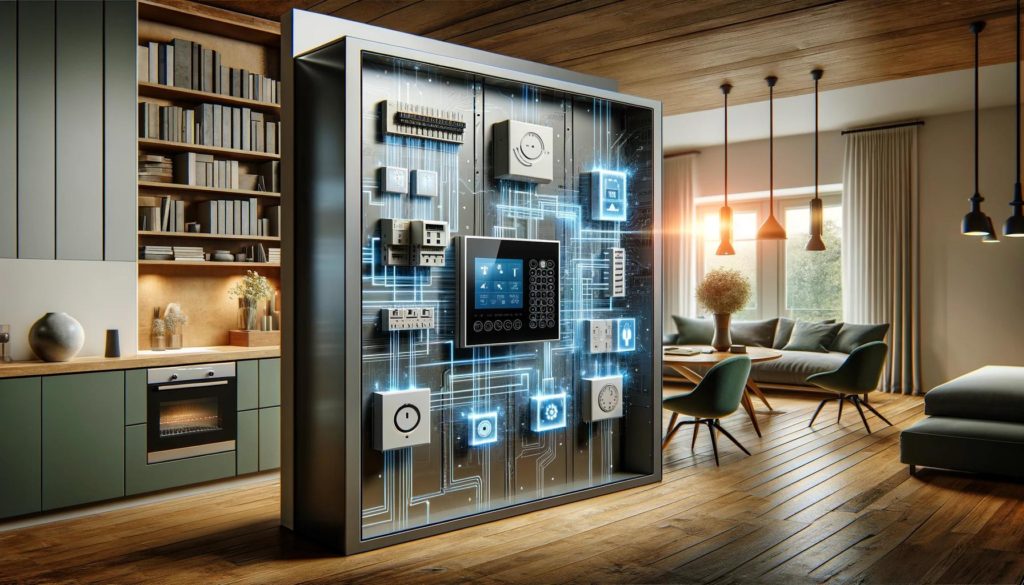The Evolution of Home Energy Management
In the quest for energy efficiency and sustainability, modern homes are increasingly turning towards innovative solutions. One of the key components in this evolution is the use of modern panelboards in home electrical systems. These panelboards, far more advanced than their predecessors, offer enhanced capabilities for managing and distributing electricity in a more efficient, safe, and smart way.
Understanding Modern Panelboards
Panelboards, also known as distribution boards, are critical elements in a home’s electrical system. They serve as the central point where the incoming power supply is divided into subsidiary circuits while providing a protective fuse or circuit breaker for each circuit in a common enclosure. Modern panelboards are designed to be more user-friendly, safer, and adaptable to various home energy needs.
Enhanced Safety Features
Safety is a paramount concern in electrical systems. Modern panelboards are equipped with state-of-the-art safety features like arc fault circuit interrupters (AFCIs) and ground fault circuit interrupters (GFCIs). These features significantly reduce the risk of electrical fires and shocks, ensuring a safer living environment.
Energy Efficiency
Modern panelboards are engineered for maximum energy efficiency. They allow for better handling and distribution of electricity, reducing energy wastage. This efficiency is not only beneficial for the environment but also translates into cost savings for homeowners.
Navigating the Installation and Maintenance of Modern Panelboards
The installation and maintenance of modern panelboards are crucial processes that require careful planning, adherence to safety standards, and technical expertise. The complexity of modern electrical systems necessitates a detailed approach to ensure both functionality and safety.
Installation Process
The installation of modern panelboards is a task that should be undertaken by a qualified electrician. It begins with a careful assessment of the home’s electrical needs. This includes evaluating the current and future power requirements, the layout of the home, and the compatibility with existing wiring. The electrician must also consider the integration of smart technology and renewable energy sources, if applicable.
Proper installation involves meticulous wiring and setup to ensure that every component functions correctly and safely. This includes the correct placement of circuit breakers and the secure connection of all wires. The installation process must comply with local building codes and electrical standards, which dictate specific requirements for electrical installations to ensure safety and functionality.
Regular Maintenance
Maintenance is vital to ensure the long-term performance and safety of the panelboard. Routine check-ups by a professional can identify potential issues before they escalate. This may include tightening connections, inspecting for signs of wear or damage, and testing the functionality of circuit breakers and safety switches.
Homeowners should also be aware of basic maintenance practices, such as periodically checking for any signs of overheating or unusual noises from the panelboard. However, qualified professionals should always carry out any major maintenance or repairs.
In summary, installing and maintaining modern panelboards require a blend of technical expertise, adherence to safety standards, and regular check-ups to ensure efficient and safe operation. Homeowners should engage with qualified electricians to navigate these processes effectively.
Customization and Control: User-Friendly Interfaces
Modern panelboards stand out for their user-friendly interfaces, which significantly enhance homeowners’ customization and control capabilities. These interfaces are designed to be intuitive, allowing even those with minimal technical knowledge to efficiently manage their home energy systems.
One key aspect of these interfaces is the customization they offer. Homeowners can tailor their energy consumption according to their specific needs and preferences. For instance, they can set schedules for appliances and systems to operate at times when energy costs are lower or adjust settings to better align with their daily routines.
Moreover, these interfaces often come with mobile app integration. This feature enables remote control and monitoring of the home’s energy usage, offering convenience and flexibility. Whether at home or away, users can adjust settings, turn off appliances, or even track their energy consumption in real-time from their smartphones.
The control provided by these interfaces extends to the integration of smart home devices. Homeowners can connect their smart thermostats, lights, and other appliances to the panelboard for centralized control. This integration simplifies home management and contributes to more efficient energy use.
In essence, the user-friendly interfaces of modern panelboards empower homeowners with more control over their energy usage, fostering a more efficient, convenient, and personalized home energy management experience. This technological advancement is not just a leap in energy management; it’s a stride toward a more connected and responsive living environment.
Integration with Renewable Energy Sources
One of the most significant advantages of modern panelboards is their compatibility with renewable energy sources like solar and wind power. These panelboards can seamlessly integrate with solar panels or wind turbines, facilitating the use of renewable energy in homes. This integration is essential for a sustainable energy future and reduces reliance on traditional power grids.
Smart Home Compatibility
Today’s panelboards are often compatible with smart home technologies. They can connect to various home automation systems, allowing homeowners to control and monitor their home energy use remotely. This feature is not only convenient but also provides real-time data to optimize energy consumption.
Maximizing Energy Efficiency with Smart Technology
The integration of smart technology with modern panelboards is revolutionizing home energy management. These advanced systems enable homeowners to maximize energy efficiency in several innovative ways.
Firstly, smart panelboards offer real-time monitoring of energy usage. This feature allows homeowners to track their electricity consumption patterns, identifying areas where they can reduce usage and save costs. By having detailed insights into their energy consumption, users can make informed decisions about their daily energy habits.
Another critical aspect is the automated control of home appliances and systems. Smart panelboards can be programmed to control lighting, heating, and cooling systems based on usage patterns and preferences. This automation ensures that energy is used only when needed, reducing unnecessary consumption. For instance, heating or cooling can be adjusted automatically depending on the time of day or the presence of occupants in the home.
Moreover, these smart systems facilitate the integration of renewable energy sources like solar panels. They can intelligently manage and distribute energy from these sources, enhancing overall efficiency. For homes equipped with solar panels, smart panelboards can optimize the use of solar energy, storing excess energy in batteries for later use or selling it back to the grid.
The use of smart technology in panelboards also extends to predictive maintenance. The system can alert homeowners about potential issues before they become major problems, ensuring that the electrical system is always running at peak efficiency.
In summary, smart panelboards are at the forefront of home energy management, offering unparalleled control, efficiency, and convenience. They are not just an upgrade to the home’s electrical system but a gateway to a more sustainable, cost-effective, and energy-efficient lifestyle.
Regulatory Compliance and Safety Standards
The installation and use of modern panelboards must adhere to stringent regulatory compliance and safety standards, which are critical for ensuring the safety and efficiency of home electrical systems. Various regulatory bodies establish these standards and cover multiple aspects of electrical system design, installation, and maintenance.
A crucial aspect of compliance is the adherence to national and international electrical codes. These codes provide guidelines on the safe installation and operation of electrical equipment, including panelboards. They ensure that the equipment used meets specific safety and performance criteria, reducing the risk of electrical fires, shocks, and other hazards.
Manufacturers of modern panelboards are also required to obtain certifications from recognized testing laboratories. These certifications confirm that the panelboards have been rigorously tested and meet the necessary safety and quality standards. This process includes evaluating the panelboard’s design, materials, and functionality.
Understanding and following these regulations and codes is essential for electricians and installers. They must stay updated with the latest standards and employ best practices during installation and maintenance. This adherence not only ensures the safety of the electrical system but also protects homeowners from potential legal and insurance issues.
Regular inspections and maintenance are also a part of compliance. These inspections ensure that the panelboards and the overall electrical system continue to operate safely and efficiently over time, aligning with the evolving standards and technological advancements.
In conclusion, regulatory compliance and adherence to safety standards are fundamental for the safe and effective use of modern panelboards in homes. They provide manufacturers, installers, and homeowners a framework to ensure the electrical system is safe, reliable, and up-to-date with the latest safety practices.
Future-Proofing Homes with Advanced Panelboards
As technology continues to evolve, modern panelboards are designed to be future-proof. They are adaptable to upcoming technologies and energy solutions, ensuring that homes remain at the forefront of energy efficiency and sustainability.
The Role of Panelboards in Net-Zero Homes
Net-zero homes, which produce as much energy as they consume, are becoming increasingly popular. Modern panelboards play a crucial role in these homes, managing and balancing energy produced by renewable sources with the home’s energy consumption.
Conclusion: Embracing the Future of Home Energy
Modern panelboards are more than just an upgrade to a home’s electrical system; it’s a step towards a more energy-efficient, safe, and sustainable living. As we continue to explore innovative energy solutions, the importance of these advanced panelboards in modern homes cannot be overstated. They are essential components in our journey towards a greener and more efficient future.
This article provides a comprehensive look at the role of modern panelboards in home energy management, emphasizing their safety, efficiency, compatibility with renewable energy, and future-proofing capabilities. With these advanced systems, homeowners can significantly enhance their home’s energy management, contributing to a more sustainable and efficient future.

